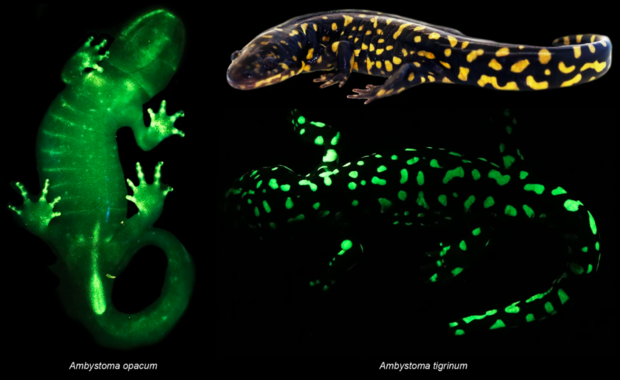Amphibians are able to glow in the dark — but scientists had no idea until now
Frogs and salamanders have been keeping a secret from humans — they can actually glow in the dark. In fact, every single species of amphibian tested in a new study was able to glow under specific lighting, shocking the scientists who observed them.
In a paper published Thursday in the journal Scientific Reports, scientists said that many amphibians have always had the ability to glow — humans just didn't know it. They tested 32 amphibian species under blue or ultra-violet light and found they have the ability to re-emit the light they absorb at another wavelength, a process known as biofluorescence.
The phenomenon has been observed in a number of animals, from jellyfish to sea turtles to sharks, but aquatic animals have been the main focus of scientists in the past. The trait was much less well-known in land-dwelling animals — until now.
After observing the ability in one salamander, researchers Jennifer Lamb and Matt Davis from St. Cloud State University in Minnesota decided to investigate just how widespread the phenomenon was across amphibian species, and how many different patterns they produced.
The researchers were surprised to find that even species that are not brightly colored under normal light reacted similarly. For example, the Rio Cauca caecilian — a gray, limbless aquatic amphibian — glowed bright green under the blue lights.
While all of the caecilians, frogs and salamanders observed were biofluorescent, scientists found there was a range in how and where they occurred: skin blotches and stripes, urine and even bones glowed bright green, yellow and orange. They also found the ability present throughout various stages of life, from tadpoles to adults.
Their glow certainly makes them look pretty, but biofluorescence may also have some practical uses for amphibians. It may be able to help them locate each other in low-light conditions, aid them in camouflage, predator mimicry and even mating, depending on the situation, scientists explained.
"One of the most exciting aspects of this work to us was that with each species we examined we were always discovering something new that could bring novel insights into the life history and biology of amphibians worldwide," Lamb said in a statement. "The Eastern tiger salamander (Ambystoma tigrinum) was the first salamander species that we surveyed for biofluorescence, and when we saw the bright, intense green light emitted from their yellow spots we each let out a collective 'Woah!'"
There are a few reasons biofluorescence may occur in these species. They could have fluorescent proteins and compounds in their skin, secretions and bones, or they may have pigment-containing and light-reflecting cells.
The study opens the door to more research on how or why amphibians are born with this special ability. Because distantly related species all exhibited the same characteristic, the trait may be able to be traced back to early amphibian evolution.
As amphibians decline worldwide largely due to habitat loss and climate change, scientists can take comfort knowing they may be able to find one in the wild and start a breeding program to save the species — using nothing more than a blue flashlight.






